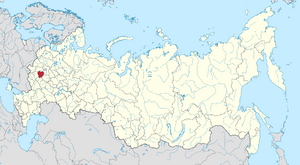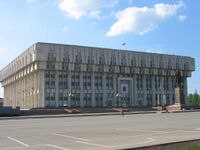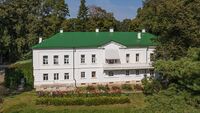أبلاست تولا
Tula Oblast | |
|---|---|
| Тульская область | |
 | |
 | |
| الإحداثيات: 53°55′N 37°35′E / 53.917°N 37.583°E | |
| البلد | روسيا |
| المنطقة الاتحادية | الوسطى[1] |
| المنطقة الاقتصادية | الوسطى[2] |
| تأسست | 26 September 1937 |
| المركز الإداري | تولا |
| الحكومة | |
| • الكيان | Oblast Duma |
| • الحاكم | Alexey Dyumin[3] |
| المساحة | |
| • Total | 25٬679 كم² (9٬915 ميل²) |
| ترتيب المساحة | 69th |
| التعداد | |
| • Estimate (2018) | 1٬491٬855 |
| منطقة التوقيت | UTC+3 (توقيت موسكو |
| ISO 3166 code | RU-TUL |
| لوحات السيارات | 71 |
| OKTMO ID | 70000000 |
| اللغات الرسمية | الروسية[6] |
| الموقع الإلكتروني | http://www.admportal.tula.ru/ |
أبلاست تولا (روسية: Ту́льская о́бласть، Tulskaya oblast) هي إحدى الكيانات الفدرالية (أوبلاست) في روسيا. It is geographically located in European Russia and is administratively part of the Central Federal District, covering an area of 25،700 متر كيلومربع (9،900 sq mi). It has a population of 1,553,925 (تعداد 2010).[7] Tula is the largest city and the administrative center of the oblast.
Tula Oblast borders Moscow Oblast in the north, Ryazan Oblast in the east, Lipetsk Oblast in the southeast, Oryol Oblast in the southwest, and Kaluga Oblast in the west. Tula Oblast is one of the most developed and urbanized territories in Russia, and the majority of the territory forms the Tula-Novomoskovsk Agglomeration, an urban area with a population of over 1 million.
وتحوي المدن والقرى التالية: أليكسين، بيليف، بوگوروديتسك، بولوخوفو، تشيكالين، دونسكوي، كيموفسك، كيرييفسك، ليبكي، نوفوموسكوفيك، بلافسك، شتشايوكينو، سوكولنيكي، سوفتسك، تولا أوبلاست، سوفوروف، تولا، روسيا، أوزلوفايا، فينيوف، ياسنوگورسك، ييفريموف،
التاريخ
The Tula Oblast area has been inhabited since the Stone Age, as shown by the discoveries of burial mounds (kurgans) and old settlements.[8] By the eighth century, these lands were occupied by the Vyatichi, an East Slavic tribe who cultivated the land, traded, and worked at crafts, confirmed by records in property registers which mention an "ancient settlement" located at the confluence of the Upa River and Tulitsa River. The first mention of the city of Tula in 1146 is found in the Nikon Chronicle, in reference to the campaign of Prince Svyatoslav Olgovich of Chernigov. At the time the lands belonged to the Ryazan Principality, and Prince Sviatoslav passed through a number of settlements, including Tula, while heading for Ryazan.[9]
الجغرافيا
يقع أوبلاست تولا في المنطقة الاتحادية المركزية، ويحد أوبلاستات موسكو، ريازان وليپيتسك و أوريول, و أوبلاست كالوگا.
الأنهار
يوجد في أوبلاست تولا أكثر من 1,600 نهر وغدير. الأنهار الرئيسية تضم:
المصادر الطبيعية
الأوبلاست ثري بمصادره من خام الحديد، clay, الحجر الجيري، واحتياطيات من الليگنيت (الفحم).[10] احتياطي الليگنيت هو جزء من حوض موسكو للفحم.
المناخ
Tula Oblast has a moderate continental climate, with warm summers and cold winters. Average January temperature is −10 °C (14 °F) in the north and −9 °C (16 °F) in the south. Average July temperature is about +19 °C (66 °F) to +20 °C (68 °F). Annual precipitation is 470 ميليمتر (19 in) in the southeast and 575 ميليمتر (22.6 in) in the northwest.
السياسة
During the Soviet period, the high authority in the oblast was shared between three persons: The first secretary of the Tula CPSU Committee (who in reality had the biggest authority), the chairman of the oblast Soviet (legislative power), and the Chairman of the oblast Executive Committee (executive power). Since 1991, CPSU lost all the power, and the head of the Oblast administration, and eventually the governor was appointed/elected alongside elected regional parliament.
The Charter of Tula Oblast is the fundamental law of the region. The Tula Oblast Duma is the province's standing legislative (representative) body. The Oblast Duma exercises its authority by passing laws, resolutions, and other legal acts and by supervising the implementation and observance of the laws and other legal acts passed by it. The highest executive body is the Oblast Government, which includes territorial executive bodies such as district administrations, committees, and commissions that facilitate development and run the day to day matters of the province. The Oblast administration supports the activities of the Governor who is the highest official and acts as guarantor of the observance of the oblast Charter in accordance with the Constitution of Russia.
التقسيمات الإدارية
الديمغرافيا
السكان: 1٬501٬214 (تعداد 2021)؛[11] 1,553,925 (تعداد 2010);[7] 1,675,758 (تعداد 2002);[12] 1,867,013 (تعداد 1989).[13]
المستوطنات
أكبر المدن أو البلدات في Tula Oblast
2010 Russian Census | |||||||||
|---|---|---|---|---|---|---|---|---|---|
| الترتيب | Administrative Division | التعداد | |||||||
 Tula  Novomoskovsk |
1 | Tula | City of oblast significance of Tula | 501,169 |  Donskoy  Aleksin | ||||
| 2 | Novomoskovsk | Novomoskovsky District | 131,386 | ||||||
| 3 | Donskoy | Town of oblast significance of Donskoy | 64,552 | ||||||
| 4 | Aleksin | Aleksinsky District | 61,732 | ||||||
| 5 | Shchyokino | Shchyokinsky District | 58,139 | ||||||
| 6 | Uzlovaya | Uzlovsky District | 55,282 | ||||||
| 7 | Yefremov | Yefremovsky District | 42,350 | ||||||
| 8 | Bogoroditsk | Bogoroditsky District | 31,897 | ||||||
| 9 | Kimovsk | Kimovsky District | 28,485 | ||||||
| 10 | Kireyevsk | Kireyevsky District | 25,557 | ||||||
| السنة | تعداد | ±% |
|---|---|---|
| 1897 | 1٬419٬456 | — |
| 1926 | 1٬505٬263 | +6.0% |
| 1959 | 1٬920٬308 | +27.6% |
| 1970 | 1٬952٬467 | +1.7% |
| 1979 | 1٬906٬176 | −2.4% |
| 1989 | 1٬867٬013 | −2.1% |
| 2002 | 1٬675٬758 | −10.2% |
| 2010 | 1٬553٬925 | −7.3% |
| 2021 | 1٬501٬214 | −3.4% |
| Source: Census data | ||
Vital statistics for 2022:[14][15]
- Births: 9,568 (6.7 per 1,000)
- Deaths: 24,860 (17.4 per 1,000)
Total fertility rate (2022):[16]
1.15 children per woman
Life expectancy (2021):[17]
Total — 68.97 years (male — 64.05, female — 73.85)
التركيبة العرقية (2010):[7]
- روس - 95.3%
- أوكران - 1%
- أرمن - 0.6%
- تتر - 0.5%
- آذريون - 0.4%
- غجر - 0.3%
- بلاروس - 0.2%
- ألمان - 0.2%
- غيرهم - 1.5%
- 19,778 people were registered from administrative databases, and could not declare an ethnicity. It is estimated that the proportion of ethnicities in this group is the same as that of the declared group.[18]
- 2002 Census population:
- Urban: 1,366,818 (81.6%)
- Rural: 308,940 (18.4%)
- Males: 755,057 (45.1%)
- Females: 920,701 (54.9%)
- Females per 1000 Males: 1219
- Average age : 41.7 years
- Urban : 41.5 years
- Rural : 42.8 years
- Male : 37.8 years
- Female : 44.9 years
- 2012
2009 - 1.31 | 2010 - 1.31 | 2011 - 1.32 | 2012 - 1.43 | 2013 - 1.42 | 2014 - 1.47 | 2015 - 1.57 | 2016 - 1.56(e)
الدين
According to a 2012 survey[21] 62% of the population of Tula Oblast adheres to the Russian Orthodox Church, 2% are unaffiliated generic Christians, 1% are Muslims. In addition, 19% of the population declares to be "spiritual but not religious", 13% is atheist, and 3% follows other religions or did not give an answer to the question.[21]
الاقتصاد
Tula Oblast is part of the Central economic region. It is a prominent industrial center with metalworking, engineering, coalmining, and chemical industries.[23] Major industrial cities include Novomoskovsk and Aleksin. Historical industries, such as firearm, samovar, and accordion manufacturing, still play an important role in the region.[بحاجة لمصدر]
The oblast also has a developed agricultural sector, which ranks 33rd in Russia in agricultural production.[9] The sector includes farming grain (wheat and rye), potatoes, sugar beets, and vegetable growing, livestock raising, and dairying.
الثقافة
Tula Oblast has more than 100 museums. Several are located in the administrative center of the oblast, the city of Tula, notably the Tula State Arms Museum, the Tula Kremlin, and the Tula Samovar Museum. Another important cultural tourist attractions is the home and country estate of Leo Tolstoy, Yasnaya Polyana, located 12 كيلومتر (7.5 ميل) outside of the city of Tula.
The oblast also has four professional theaters, a philharmonic orchestra, and a circus.
انظر أيضاً
المراجع
- ^ Президент Российской Федерации. Указ №849 от 13 мая 2000 г. «О полномочном представителе Президента Российской Федерации в федеральном округе». (President of the Russian Federation. Decree #849 of May 13, 2000 On the Plenipotentiary Representative of the President of the Russian Federation in a Federal District).
- ^ Госстандарт Российской Федерации. №ОК 024-95 27 декабря 1995 г. «Общероссийский классификатор экономических регионов. 2. Экономические районы», в ред. Изменения №5/2001 ОКЭР. (گوستاندارت of the Russian Federation. #OK 024-95 December 27, 1995 Russian Classification of Economic Regions. 2. Economic Regions, as amended by the Amendment #5/2001 OKER).
- ^ خطأ استشهاد: وسم
<ref>غير صحيح؛ لا نص تم توفيره للمراجع المسماةLenta-Retired - ^ Федеральная служба государственной статистики (Federal State Statistics Service) (2004-05-21). "Территория, число районов, населённых пунктов и сельских администраций по субъектам Российской Федерации (Territory, Number of Districts, Inhabited Localities, and Rural Administration by Federal Subjects of the Russian Federation)". Всероссийская перепись населения 2002 года (All-Russia Population Census of 2002) (in الروسية). Federal State Statistics Service. Retrieved 2011-11-01.
- ^ "Об исчислении времени". Официальный интернет-портал правовой информации (in الروسية). 3 June 2011. Retrieved 19 January 2019.
- ^ الرسمية في جميع أرجاء روسيا الاتحادية حسب الفقرة 68.1 من دستور روسيا.
- ^ أ ب ت Russian Federal State Statistics Service (2011). "Всероссийская перепись населения 2010 года. Том 1". Всероссийская перепись населения 2010 года (2010 All-Russia Population Census) (in Russian). Federal State Statistics Service. Retrieved June 29, 2012.
{{cite web}}: Invalid|ref=harv(help); Unknown parameter|trans_title=ignored (|trans-title=suggested) (help)CS1 maint: unrecognized language (link) - ^ For example, at the Satinskoye settlement site. Yushkova, Maria A. (2012). "Northwestern Russia at the periphery of the north European and Volga-Uralic Bronze Age". In Anfinset, Nils; Wrigglesworth, Melanie (eds.). Local Societies in Bronze Age Northern Europe. London: Equinox (Acumen). pp. 129–147. ISBN 978-1-84553-742-5.
- ^ أ ب "Tula Region". Kommersant Moscow. 8 مارس 2004. Archived from the original on 30 September 2007.
- ^ "Tula Oblast". Merriam-Webster's Geographical Dictionary (2001). Retrieved 2006-10-31.
- ^ invalid reference parameter
- ^ Федеральная служба государственной статистики (Federal State Statistics Service) (2004-05-21). "Численность населения России, субъектов Российской Федерации в составе федеральных округов, районов, городских поселений, сельских населённых пунктов – районных центров и сельских населённых пунктов с населением 3 тысячи и более человек[[Category:Articles containing روسية-language text]] (Population of Russia, its federal districts, federal subjects, districts, urban localities, rural localities—administrative centers, and rural localities with population of over 3,000)". Всероссийская перепись населения 2002 года (All-Russia Population Census of 2002) (in Russian). Federal State Statistics Service. Retrieved 2008-07-25.
{{cite web}}: URL–wikilink conflict (help)CS1 maint: unrecognized language (link) - ^ "Всесоюзная перепись населения 1989 г. Численность наличного населения союзных и автономных республик, автономных областей и округов, краёв, областей, районов, городских поселений и сёл-райцентров.[[Category:Articles containing روسية-language text]] (All Union Population Census of 1989. Present population of union and autonomous republics, autonomous oblasts and okrugs, krais, oblasts, districts, urban settlements, and villages serving as district administrative centers.)". Всесоюзная перепись населения 1989 года (All-Union Population Census of 1989) (in Russian). Demoscope Weekly (website of the Institute of Demographics of the State University—Higher School of Economics. 1989. Retrieved 2007-12-13.
{{cite web}}: Italic or bold markup not allowed in:|publisher=(help); URL–wikilink conflict (help)CS1 maint: unrecognized language (link) - ^ "Information on the number of registered births, deaths, marriages and divorces for January to December 2022". ROSSTAT. Archived from the original on 2 March 2023. Retrieved 21 February 2023.
- ^ "Birth rate, mortality rate, natural increase, marriage rate, divorce rate for January to December 2022". ROSSTAT. Archived from the original on 2 March 2023. Retrieved 21 February 2023.
- ^ Суммарный коэффициент рождаемости [Total fertility rate]. Russian Federal State Statistics Service (in الروسية). Archived from the original (XLSX) on 10 August 2023. Retrieved 10 August 2023.
- ^ "Демографический ежегодник России" [The Demographic Yearbook of Russia] (in الروسية). Federal State Statistics Service of Russia (Rosstat). Retrieved 2022-06-01.
- ^ http://www.perepis-2010.ru/news/detail.php?ID=6936
- ^ "Том 1. Численность и размещение населения: Итоги ВПН-2010" [Volume 1. Population and population distribution: Results of VPN-2010].
- ^ http://www.gks.ru/wps/wcm/connect/rosstat_main/rosstat/ru/statistics/publications/catalog/doc_1137674209312
- ^ أ ب ت "Arena: Atlas of Religions and Nationalities in Russia". Sreda, 2012.
- ^ 2012 Arena Atlas Religion Maps. "Ogonek", № 34 (5243), 27/08/2012. Retrieved 21/04/2017. Archived.
- ^ "Tula". Encyclopædia Britannica Online. Retrieved 2006-10-31.
وصلات خارجية
- Pages using gadget WikiMiniAtlas
- Articles containing روسية-language text
- CS1 الروسية-language sources (ru)
- CS1 errors: unsupported parameter
- CS1 errors: URL–wikilink conflict
- CS1 errors: markup
- CS1 uses الروسية-language script (ru)
- Short description is different from Wikidata
- Coordinates on Wikidata
- Pages using Lang-xx templates
- Articles with hatnote templates targeting a nonexistent page
- مقالات ذات عبارات بحاجة لمصادر
- أبلاست تولا
- دول وأقاليم تأسست في 1937
- تأسيسات 1937 في الاتحاد السوڤيتي
- اوبلاستات روسيا



